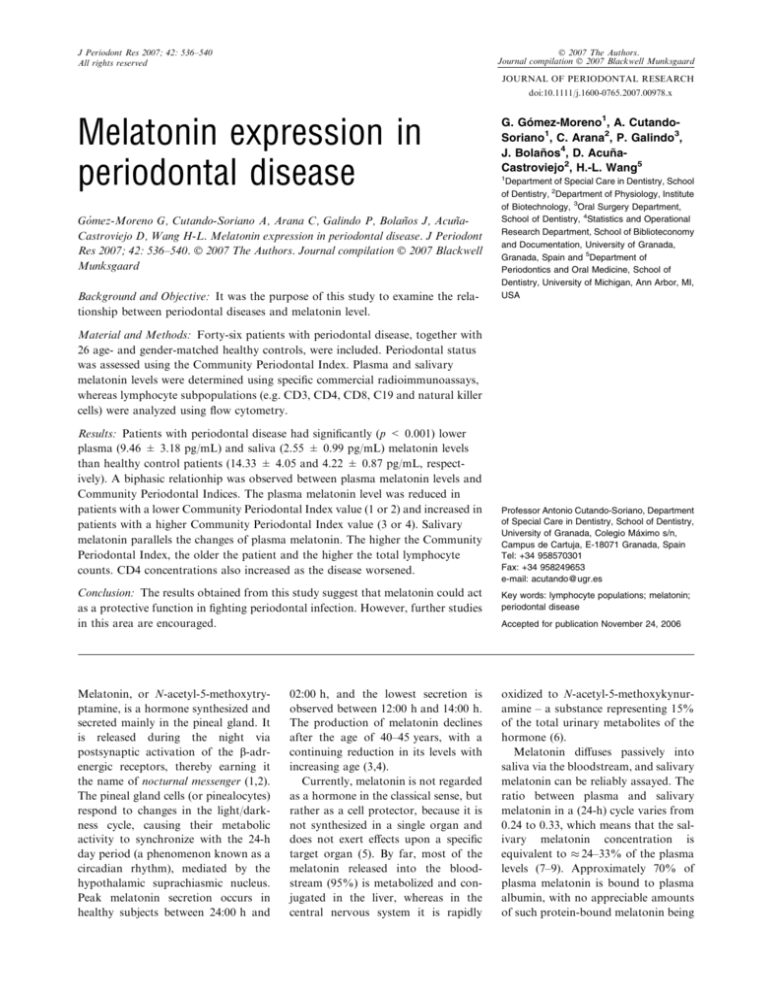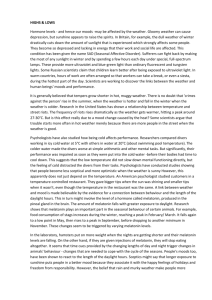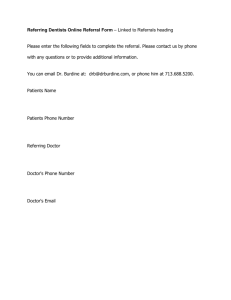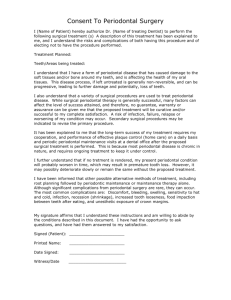
2007 The Authors.
Journal compilation 2007 Blackwell Munksgaard
J Periodont Res 2007; 42: 536–540
All rights reserved
JOURNAL OF PERIODONTAL RESEARCH
doi:10.1111/j.1600-0765.2007.00978.x
Melatonin expression in
periodontal disease
Gómez-Moreno G, Cutando-Soriano A, Arana C, Galindo P, Bolaños J, AcuñaCastroviejo D, Wang H-L. Melatonin expression in periodontal disease. J Periodont
Res 2007; 42: 536–540. 2007 The Authors. Journal compilation 2007 Blackwell
Munksgaard
Background and Objective: It was the purpose of this study to examine the relationship between periodontal diseases and melatonin level.
G. Gmez-Moreno1, A. CutandoSoriano1, C. Arana2, P. Galindo3,
J. BolaÇos4, D. AcuÇaCastroviejo2, H.-L. Wang5
1
Department of Special Care in Dentistry, School
of Dentistry, 2Department of Physiology, Institute
of Biotechnology, 3Oral Surgery Department,
School of Dentistry, 4Statistics and Operational
Research Department, School of Biblioteconomy
and Documentation, University of Granada,
Granada, Spain and 5Department of
Periodontics and Oral Medicine, School of
Dentistry, University of Michigan, Ann Arbor, MI,
USA
Material and Methods: Forty-six patients with periodontal disease, together with
26 age- and gender-matched healthy controls, were included. Periodontal status
was assessed using the Community Periodontal Index. Plasma and salivary
melatonin levels were determined using specific commercial radioimmunoassays,
whereas lymphocyte subpopulations (e.g. CD3, CD4, CD8, C19 and natural killer
cells) were analyzed using flow cytometry.
Results: Patients with periodontal disease had significantly (p < 0.001) lower
plasma (9.46 ± 3.18 pg/mL) and saliva (2.55 ± 0.99 pg/mL) melatonin levels
than healthy control patients (14.33 ± 4.05 and 4.22 ± 0.87 pg/mL, respectively). A biphasic relationhip was observed between plasma melatonin levels and
Community Periodontal Indices. The plasma melatonin level was reduced in
patients with a lower Community Periodontal Index value (1 or 2) and increased in
patients with a higher Community Periodontal Index value (3 or 4). Salivary
melatonin parallels the changes of plasma melatonin. The higher the Community
Periodontal Index, the older the patient and the higher the total lymphocyte
counts. CD4 concentrations also increased as the disease worsened.
Conclusion: The results obtained from this study suggest that melatonin could act
as a protective function in fighting periodontal infection. However, further studies
in this area are encouraged.
Melatonin, or N-acetyl-5-methoxytryptamine, is a hormone synthesized and
secreted mainly in the pineal gland. It
is released during the night via
postsynaptic activation of the b-adrenergic receptors, thereby earning it
the name of nocturnal messenger (1,2).
The pineal gland cells (or pinealocytes)
respond to changes in the light/darkness cycle, causing their metabolic
activity to synchronize with the 24-h
day period (a phenomenon known as a
circadian rhythm), mediated by the
hypothalamic suprachiasmic nucleus.
Peak melatonin secretion occurs in
healthy subjects between 24:00 h and
02:00 h, and the lowest secretion is
observed between 12:00 h and 14:00 h.
The production of melatonin declines
after the age of 40–45 years, with a
continuing reduction in its levels with
increasing age (3,4).
Currently, melatonin is not regarded
as a hormone in the classical sense, but
rather as a cell protector, because it is
not synthesized in a single organ and
does not exert effects upon a specific
target organ (5). By far, most of the
melatonin released into the bloodstream (95%) is metabolized and conjugated in the liver, whereas in the
central nervous system it is rapidly
Professor Antonio Cutando-Soriano, Department
of Special Care in Dentistry, School of Dentistry,
University of Granada, Colegio Mximo s/n,
Campus de Cartuja, E-18071 Granada, Spain
Tel: +34 958570301
Fax: +34 958249653
e-mail: acutando@ugr.es
Key words: lymphocyte populations; melatonin;
periodontal disease
Accepted for publication November 24, 2006
oxidized to N-acetyl-5-methoxykynuramine – a substance representing 15%
of the total urinary metabolites of the
hormone (6).
Melatonin diffuses passively into
saliva via the bloodstream, and salivary
melatonin can be reliably assayed. The
ratio between plasma and salivary
melatonin in a (24-h) cycle varies from
0.24 to 0.33, which means that the salivary melatonin concentration is
equivalent to 24–33% of the plasma
levels (7–9). Approximately 70% of
plasma melatonin is bound to plasma
albumin, with no appreciable amounts
of such protein-bound melatonin being
Melatonin expression in periodontal disease
found in the saliva. Thus, salivary
melatonin represents the portion of
circulating melatonin not bound to
proteins (i.e. the free fraction of the
hormone).
Melatonin
modulates
immune responses, protects cells via
anti-inflammatory effects (acting as an
antioxidant and free radical scavenger),
stimulates type I collagen synthesis and
promotes bone formation (10–27).
An important consideration in
periodontal disease is the generation of
free radicals (28), some of which derive
from the oral bacteria themselves,
others originating from the induced
immune response (29–30). It has been
suggested that an increase in both
reactive oxygen and nitrogen species
during periodontal disease is responsible
for the oxidative damage to periodontal
tissues (31). The increase in free radical
production co-exists with a decrease in
antioxidant defense. The imbalance
between the pro-oxidant and antioxidant
systems may lead to further oxidative
attack and to substantial deterioration
of the periodontal tissues (32,33).
However, the relationship between
periodontal diseases and melatonin
level remains unknown. Hence, the
present study was conducted to examine
the relationship between periodontal
disease and melatonin levels, as well as
to assess the lymphocyte subpopulations (e.g. CD3, CD4, CD8, CD19 and
natural killer) and their relationship to
melatonin.
with periodontal disease were: age 18–
65 years; and evidence of periodontal
disease (e.g. bone loss, pocket depth).
Exclusion criteria included the presence of other concomitant systemic
disorders (such as epilepsy and schizophrenia) and diseases capable of
affecting the immune system, such as
chronic infectious and neoplastic processes (35,36). Patients receiving pharmacological treatment that could alter
melatonin levels were excluded from
the study (37,38).
Data were assessed by a singlemasked examiner. The intra-examiner
reliability was calculated to be 84%.
Periodontal status was evaluated using
the Community Periodontal Index
(34). The Community Periodontal
Index, currently recommended by the
World Health Organization, consists
of dividing the oral cavity into six
sextants, with tooth indexing in each.
Teeth index are 17/16 for the first sextant, 11 for the second, 26/27 for the
third, 36/37 for the fourth, 31 for the
fifth and 47/46 for the sixth. Teeth were
examined using a probe with two
marks located at 3.5 and 5.5 mm. The
Community Periodontal Index scores
used for recording periodontal status
were as follows: 0 ¼ healthy periodontium; 1 ¼ moderate bleeding; 2 ¼
presence of supra- or subgingival
dental calculus; 3 ¼ periodontal pocket measuring 4–5 mm; and 4 ¼ periodontal pocket 6 mm or more in depth.
Material and methods
Determination of plasma melatonin
A total of 72 subjects were included in
the study. Informed consent was
obtained from all patients before
participation in the study, which was
approved by the University Ethics
Committee and performed in accordance with the Code of Ethics of the
World Medical Association according
to the Declaration of Helsinki. The
subjects were divided into two groups:
control (26 healthy subjects, 15 women
and 11 men, 47.2 ± 9.1 years); and
test (46 age- and gender-matched
patients with periodontal disease).
A dental and medical history was
compiled for all patients, following
World Health Organization criteria
(34). The inclusion criteria for patients
Both test and control patients reported
to the laboratory at 08:00 h and were
seated for 30 min before sampling.
Blood samples (20 mL) were collected
from the antecubital vein and centrifuged at 3000 g for 10 min, followed
by separation of the plasma fraction,
which was then frozen ()20C) until
assay (39). Plasma melatonin was
determined using a commercial radioimmunoassay
(DVD
Biochemie
GmbH, Marburg, Germany) (40,41),
and a quality control was performed
yielding intra- and interassay coefficients of variation of 10.5% and 5.9%,
respectively. The recovery of added
melatonin was 86.3%, with an assay
sensitivity of 4.45 pg/mL.
537
Determination of salivary melatonin
Saliva was obtained after chewing a
piece of paraffin. Saliva produced
during the first 2 min was discarded.
Saliva (5–10 mL) was then collected
during the following 5 min, avoiding
any possible contamination. The saliva samples were centrifuged at 3000 g
for 20 min, and the clear supernatant
was frozen at )20C. Melatonin levels
in saliva were measured by radioimmunoassay (IBL GmbH, Hamburg,
Germany) (42), and a quality control
was performed yielding intra- and
interassay coefficients of variation of
11.8% and 6.3%, respectively. The
recovery of added melatonin was
82.5%, with an assay sensitivity of
2.09 pg/mL.
Determination of lymphocyte
subpopulations
A flow cytometer (Becton Dickinson
FACS Vantage; Becton Dickinson,
Franklin Lakes, NJ, USA) was used to
quantify the lymphocyte subpopulations.
Determination of CD4+ and CD8+
lymphocytes
CD4 and CD8 are markers for T
lymphocytes. Ortho Trio CD4/CD8/
CD3 monoclonal antibodies were used
to identify these subpopulations.
These antibodies are supplied as a
mixture of three mouse monoclonal
antibodies: CD4 conjugated to fluorescein isothiocyanate; CD8 conjugated to phycoerythrin; and CD3
conjugated to the tandem cyano-5phycoerythrin.
Determination of CD16+ and CD19+
lymphocytes
CD16 and CD19 are markers for B
lymphocytes. We used Ortho Trio
CD16/CD19/CD3 monoclonal antibodies, which are supplied as a mixture
of three mouse monoclonal antibodies
(CD16 conjugated to fluorescein
isothiocyanate, CD19 conjugated to
phycoerythrin and CD3 conjugated
to the tandem cyano-5-phycoerythrin),
to identify these subpopulations.
Gómez-Moreno et al.
Determination of natural killer cells
The clone HP 2/1 (conjugated to fluorescein isothiocyanate) was used to
identify natural killer cells. The reagent
from Immunotech-Coulter Co. (Marseille, France) (cat. no: 1404) was used
in the test.
Statistical analysis
Quantitative variables were expressed
as mean ± standard deviation,
whereas absolute and relative frequencies were calculated for qualitative
variables. The Mann–Whitney U-test
was used to correlate quantitative with
qualitative variables, and the Student’s
t-test was applied to compare the
means of quantitative variables. The
Spearman correlation coefficient was
used to correlate quantitative and
qualitative variables. The behavior of
the
lymphocyte
subpopulations
(expressed as percentages) was investigated using the Welch test. The
relationship between a qualitative
variable with more than two modalities
(Community Periodontal Index) and
the quantitative variables was examined by the Kruskal–Wallis test and/or
one-way analysis of variance.
Results
Table 1 shows the comparison between
periodontal disease patients and healthy
individuals. The patients with periodontal disease had significantly lower
plasma and salivary melatonin concentrations than the healthy subjects
(p < 0.001). However, the salivary/
plasma melatonin ratio was similar in
both groups. A significant, negative
correlation was found between plasma
melatonin and age in the control group
(r ¼ )0.672, p < 0.001). In healthy
individuals, the older the patient, the
higher the plasma melatonin concentration. However, this correlation was
not noted in the periodontal disease patients (r ¼ 0.02, not significant). When
the percentage of lymphocyte subpopulations was examined, no difference was
noted between test and control subjects,
except for CD3. Periodontal disease
patients showed a significantly higher
percentage of CD3+ lymphocytes than
the control group (p < 0.05).
Application of the Kruskal–Wallis
test yielded a p-value of < 0.001,
reflecting the age-dependent increase in
the Community Periodontal Index
(Table 2).
A
biphasic
relationship
was
observed between plasma melatonin
and the Community Periodontal
Index. The plasma melatonin level was
decreased in patients with a Community Periodontal Index of 1–2 (the
youngest patients), and increased to
peak values in patients with a Community Periodontal Index of 4. Salivary
melatonin was shown to parallel the
changes of plasma melatonin (Fig. 1).
Patients with a Community Periodontal Index score of 4 showed the
Table 2. Mean patient age according to the
Community Periodontal Index (CPI) score
CPI
n
Age (years)
1
2
3
4
9
11
17
9
39.9
50.2
56.6
61.6
highest T-cell counts (Fig. 2). On
evaluating CD4+ cell behaviour and
the Community Periodontal Index
(F ¼ 0.77; not significant), it was
found that when the Community
Periodontal Index was ‡ 3, the CD4+
lymphocyte count increased. Moreover, in patients with a Community
Periodontal Index of 4, the CD8+
15
Plasma
melatonin
Controls (n ¼ 26)
Age
PM
SM
SM/PM ratio
CD3+
CD19+
CD4+
CD8+
NK+
47.2
14.33
4.22
0.30
73
9.5
44.5
29.5
10.5
52.07
9.46
2.55
0.31
78.39
10.31
46.56
28.29
11.91
±
±
±
±
±
±
±
±
±
9.1
4.05
0.87
0.06
11.2
3.0
13.7
7.8
8.2
±
±
±
±
±
±
±
±
±
9.3
3.18**
0.99**
0.07
7.89***
4.43
9.17
9.57
6.35
Data are given as mean ± SD. Age is expressed in years, melatonin in pg/mL, and the
lymphocyte subpopulations in percentages. Values in parenthesis indicate the number of
cases.
NK, natural killer; PM, plasma melatonin; SM, salivary melatonin.
**p < 0.001 vs. control.
***p < 0.05 on applying the Welch test.
Saliva
melatonin
10
5
0
1
2
3
CPI index
4
Fig. 1. Plasma and saliva melatonin levels
in patients with periodontal disease.
CD4
CD8
CD19
2050
Lymphocytes number
Variable
10.6
8.6
10.3
7.8
Data are expressed as the mean ± SD; n ¼
number of cases.
Table 1. Comparison of the study variables between the controls and patients with periodontal disease
Periodontitis
patients (n ¼ 46)
±
±
±
±
pg/mL
538
CD3
NK
1640
1230
820
410
0
1
2
3
4
CPI index
Fig. 2. Lymphocyte subpopulations among
periodontal patients in relation to the
Community Periodontal Index (CPI). NK,
natural killer.
Melatonin expression in periodontal disease
T-cell count was increased (F ¼ 0.50;
not significant). The lowest CD8+
count was observed in subjects with a
Community Periodontal Index score of
1 (F ¼ 0.43; not significant) (Fig. 2).
The patients with a Community
Periodontal Index score of 1 presented
the highest number of B lymphocytes
(Fig. 2). The number of B lymphocytes
decreased at a Community Periodontal
Index score of 2 (age inflexion point) to a
minimum at a Community Periodontal
Index score of 3. Nevertheless, a rise was
subsequently recorded at a Community
Periodontal Index score of 4 (F ¼ 0.77;
not significant). Regarding the natural
killer cells (F ¼ 1.46; not significant), the
counts increased with increasing Community Periodontal Index score.
An r of )0.305 (p < 0.05) was found
between the percentage of CD4+ T cells
and plasma melatonin concentration.
Similar results were obtained on relating
CD4+ percentage to salivary melatonin, because the salivary concentrations
of the hormone parallel those found in
plasma (r ¼ )0.255; p < 0.01).
Discussion
The importance of melatonin in relation
to the immune system has been established, and melatonin is presently being
used as coadjutant therapy in patients
with certain tumors because it effectively reinforces the host immune defenses (26,43,44). In the present study,
melatonin levels in healthy subjects were
significantly lower in older individuals.
This situation could be attributed to the
known decrease in the production of
melatonin as individuals begin to age
(i.e. at around 40–45 years old). However, the older patients preserved their
response capacity to Community Periodontal Index scores of 3 and 4, attaining
melatonin concentrations, in plasma
(Community Periodontal Index 3,
8.5 pg/mL; Community Periodontal
Index 4, 13.5 pg/mL) and in saliva
(Community Periodontal Index 3,
2.5 pg/mL; Community Periodontal
Index 4, 3.8 pg/mL), that were lower
than in healthy individuals but sufficient
to maintain periodontal stability
(Tables 1 and 2). In earlier studies
(22,23), this increase in salivary and
plasma melatonin resulted in stimula-
tion of the CD4+ T cells, which possess
membrane and nuclear receptors for the
hormone (20,21). This would stimulate
the other immune cell populations via
cytokine secretion (e.g. CD3+, CD19+,
CD4+ and CD8+ cells with natural
killer cell stimulation) – thereby facilitating the host reaction to an existing
oral infection. This is in agreement with
our data that indicated the higher the
Community Periodontal Index index
score, the greater the total lymphocyte
counts (F ¼ 0.73; not significant). Furthermore, our data also showed that
when oral health is deficient and infectious foci develop (e.g. at a Community
Periodontal Index score of 3), the CD4+
lymphocyte count expanded – in close
similarity to the melatonin concentration curve.
Data from our study showed that
periodontal disease patients with lower
CD4+ counts tend to exhibit higher
melatonin levels. Considering that the
immune cell populations increase as
melatonin concentrations rise in situations of increasing Community Periodontal Index scores, the question arises
as to what causes melatonin to increase
at a given moment and stimulate the
host immune system. In this context,
melatonin possesses two functions of
great interest to dental professionals:
(i) its capacity to scavenge free radicals,
thereby exerting antioxidative action
(clearly surpassing all known antioxidants such as vitamin C, E and
coenzyme Q) (45–49); and (ii) the cellprotective effect exerted by melatonin
in situations of inflammation (13,28),
stimulating bone regeneration by favoring collagen type I production (18)
and modulating osteoblast and osteoclast activity (16,19).
On examining the effects of melatonin upon the immune system, it may be
considered that abundant reactive
oxygen species are produced in situations of periodontal disease, characterized by an increase in peroxidation
products generated by the infiltrating
polymorphonuclear cell population
(31), this, in turn, leading to an increase
in melatonin levels. From our perspective, this not only would stimulate the
immune system through the plasma
fraction of the hormone, but would
also afford local protection though the
539
salivary melatonin fraction (50). As a
result, the bone and cell population
affected by the periodontal process
would be protected from the reactive
oxygen species generated by the existing inflammatory process, and bone
repair would also be stimulated. Such
effects could open new perspectives for
the treatment of oral inflammatory
processes (50,51). In conclusion, the
results obtained from this study suggest
that melatonin could have a protective
function in fighting periodontal infection. However, future studies in this
area are encouraged to validate the
initial results reported here.
Acknowledgements
This work was carried out partially
with the assistance of grants CTS-263
from the Consejerı́a de Educación,
Junta de Andalucı́a, Spain.
References
1. Bergstrom WH, Hakanson DO. Melatonin: the dark force. Adv Pediatr 1998;
45:91–106.
2. Deguchi T, Axelrod J. Control of circadian change of serotonin N-acetyltransferase in the pineal gland by b-adrenergic
receptor. Proc Natl Acad Sci USA
1973;70:2411–2414.
3. Brainard GC, Petterborg LJ, Richardson
BA, Reiter RJ. Pineal melatonin in syrian
hamsters: circadian and seasonal rhythms
in animals maintained under laboratory
and natural conditions. Neuroendocrinology 1982;35:342–348.
4. Reiter RJ. Pineal melatonin: cell biology
of its synthesis and physiological interactions. Endocr Rev 1991;12:151–180.
5. Vakkuri O, Leppaluoto J, Kauppila A.
Oral administration and distribution of
melatonin in human serum, saliva and
urine. Life Sci 1985;37:489–495.
6. Wurtman RJ, Moskowitz M. The pineal
organ (first of two parts). N Engl J Med
1977;296:1329–1333.
7. Laakso ML, Porkka-Heiskanen T, Alila
A, Stenberg D, Johansson G. Correlation
between salivary and serum melatonin:
dependence on serum melatonin levels.
J Pineal Res 1990;9:39–50.
8. McIntyre IM, Norman TR, Burrows GD,
Armstrong SM. Melatonin rhythm in
human plasma and saliva. J Pineal Res
1987;4:177–183.
9. Vakkuri O. Diurnal rhythm of melatonin
in human saliva. Acta Physiol Scand
1985;124:409–412.
540
Gómez-Moreno et al.
10. Acuña-Castroviejo D, Escames G, Carazo
A, León J, Khaldy H, Reiter RJ. Melatonin, mitochondrial homeostasis and
mitochondrial-related diseases. Curr Top
Med Chem 2002;2:133–151.
11. Allegra M, Reiter RJ, Tan DX, Gentile C,
Tesoriere L, Livrea MA. The chemistry of
melatonin’s interaction with reactive species. J Pineal Res 2003;34:1–10.
12. Reiter RJ, Guerrero JM, Garcı́a JJ, Acuña-Castroviejo D. Reactive oxygen intermediates, molecular damage, and aging.
Ann N Y Acad Sci 1998;854:410–424.
13. Chapple IL. Reactive oxygen species and
antioxidants in inflammatory diseases.
J Clin Periodontol 1997;24:287–296.
14. Martı́n M, Macı́as M, Escames G, León J,
Acuña-Castroviejo D. Melatonin, but not
vitamins C and E, maintains glutathione
homeostasis in t-butyl hydroperoxideinduced mitochondrial oxidative stress.
FASEB J 2000;14:1677–1679.
15. Tan DX, Manchester LC, Reiter RJ, Qi
WB, Karbownik M, Calvo JR. Significance of melatonin in antioxidative defense system: reactions and products. Biol
Signals Recept 2000;9:137–159.
16. Cardinali DP, Ladizesky MG, Boggio V,
Cutrera RA, Mautalen C. Melatonin
effects on bone: experimental facts and
clinical perspectives. J Pineal Res 2003;
34:81–87.
17. Ladizesky MG, Boggio V, Albornoz LE,
Castrillon PO, Mautalen C, Cardinali DP.
Melatonin increases oestradiol-induced
bone formation in ovariectomized rats.
J Pineal Res 2003;34:143–151.
18. Nakade O, Koyama H, Arijii H, Yajima
A, Kaku T. Melatonin stimulates proliferation and type I collagen synthesis in
human bone cells in vitro. J Pineal Res
1999;27:106–110.
19. Ostrowska Z, Kos-Kudla B, Marek B,
Swietochowswka E, Gorki J. Assessment
of the relationship between circadian variations of salivary melatonin levels and
type I collagen metabolism in postmenopausal obese women. Neuroendocrinology
2001;22:121–127.
20. Garcı́a-Maurino S, González-Haba MG,
Calvo JR, Goberna R, Guerrero JM.
Involvement of nuclear binding sites for
melatonin in the regulation of IL-2 and
IL-6 production by human blood mononuclear cells. J Neuroimmunol 1998;92:76–
84.
21. Guerrero JM, Pozo D, Garcı́a-Maurino S,
Osuna C, Molinero P, Calvo JR.
Involvement of nuclear receptors in the
enhanced IL-2 production by melatonin in
Jurkat cells. Ann NY Acad Sci
2000;91:7397–7403.
22. Maestroni GJ, Conti A. The pineal neurohormone melatonin stimulates activated
CD4+, Thy-1+ cells to release opioid
agonist(s) with immunoenhancing and
23.
24.
25.
26.
27.
28.
29.
30.
31.
32.
33.
34.
35.
36.
37.
anti-stress properties. J Neuroimmunol
1990;28:167–176.
Maestroni GJ. The immunotherapeutic
potential of melatonin. Expert Opin Invest
Drugs 2001;10:467–476.
Maestroni GJ, Conti A, Pierpaoli W. Role
of the pineal gland in immunity. Melatonin antagonizes the immunosuppressive
effect of acute stress via an opiatergic
mechanism. Immunology 1988;63:465–469.
Caroleo MC, Frasca D, Nistico G, Doria
G. Melatonin as immunomodulator in
immunodeficient mice. Immunopharmacology 1992;23:81–89.
Lissoni P, Barni S, Archili C et al. Endocrine effects of a 24-hour intravenous
infusion of interleukin-2 in the immunotherapy of cancer. Anticancer Res
1990;10:753–757.
Kelley KW. Growth hormone in immunobiology. In: Ader R, Felten N, Cohen
N, eds. Psychoneuroimmunology II. San
Diego: Academic Press, 1991:377–403.
Battino M, Bullon P, Wilson M, Newman
H. Oxidative injury and inflammatory
periodontal diseases: the challenge of antioxidants to free radicals and reactive
oxygen species. Crit Rev Oral Biol Med
1999;10:458–476.
Gustafson A, Asman B. Increased release
of free oxygen radicals from peripheral
neutrophils in adult periodontitis after
Fcc-receptor stimulation. J Clin Periodontol 1996;23:38–44.
Zambon JJ, Reynolds H, Fisher JG,
Shlossman M, Dunford R, Genco RJ.
Microbiological and immunological studies of adult periodontitis in patients with
non insulin-dependent diabetes mellitus.
J Periodontol 1998;59:23–31.
Kimura S, Yonemura T, Kaya H.
Increased oxidative product formation by
peripheral blood polymorphonuclear leukocytes in human periodontal disease.
J Periodont Res 1993;28:197–203.
Halliwell B. Free radicals, antioxidants
and human disease: curiosity, cause or
consequence. Lancet 1994;344:721–724.
Sies H. Oxidative stress: oxidants and
antioxidants. Exp Physiol 1997;82:191–
295.
WHO. Oral Health Surveys: Basic Methods, 4th edn. World Health Organization:
Geneva, 1997.
Kawamura N, Kim Y, Asukai N. Suppression of cellular immunity in men with
a past history of posttraumatic stress disorder. Am J Psychiatry 2001;158:484–486.
Kronfol Z, Remick DG. Cytokines and
the brain: implications for clinical psychiatry. Am J Psychiatry 2000;157:683–694.
Glaser R, Rabin B, Chesney M, Cohen S,
Natelson B. Stress-induced immunomodulation: implications for infectious
diseases? J Am Med Assoc 1999;281:2268–
2270.
38. Gómez F, Ruiz P, Briceno F, López R,
Michan A. Treatment with progesterone
analogues decreases macrophage Fc gamma receptor expression. Clin Immunol
Immunopathol 1998;89:231–239.
39. Kennaway DJ, Voultsios A. Circadian
rhythm of free melatonin in human plasma.
J
Clin
Endocrinol
Metab
1998;
83:1013–1015.
40. Arent J, Paunier L, Sizonenko PC. Melatonin radioimmunoassay. J Clin Endocrinol Metab 1975;40:347–350.
41. Kennaway DJ, Frith RG, Phillipou G,
Matthews CD, Seamark RF. A specific
radioimmunoassay for melatonin in biological tissue and fluids and its validation
by gas chromatograph-mass spectrometry.
Endocrinology 1977;101:119–127.
42. Miles A, Thomas DR, Grey JE, Pugh AJ.
Salivary melatonin assay in laboratory
medicine – longitudinal profiles of secretion in healthy men. Clin Chem
1987;33:1957–1959.
43. Neri B, De Leonardis V, Gemelli MT.
Melatonin as biological response modifier
in cancer patients. Anticancer Res
1998;18:1329–1332.
44. Solar P. Melatonin and its wide-spectrum
effects: use of melatonin in the treatment
of tumors. Cesk Fysiol 1999;48:27–40.
45. Baydas G, Canatan H, Turkoglu A.
Comparative analysis of the protective
effects of melatonin and vitamin E on
streptozocin-induced diabetes mellitus.
J Pineal Res 2002;32:225–230.
46. Hanioka T, Mcree JT, Xia LJ. Therapy
with coenzyme Q10 for patients with periodontal disease. 2. Effect of coenzyme Q10
for patients on the immune system. J Dent
Health 1993;43:667–672.
47. Reiter RJ, Tan DX, Acuña-Castroviejo D.
Melatonin: mechanisms and actions as an
antioxidant. Curr Top Biophys 2000;
24:171–183.
48. Tan DX, Reiter RJ, Manchester LC et al.
Chemical and physical properties and
potential mechanisms: melatonin as a
broad spectrum antioxidant and free radical scavenger. Curr Top Med Chem
2002;2:181–197.
49. Zhang Z, Araghinikman M, Liang B et al.
Prevention of immune dysfunction and
vitamin E loss by dehydroepiandrosterone
and melatonin supplementation during
murine retrovirus infection. Immunology
1999;96:291–297.
50. Cutando A, Gómez-Moreno G, Villalba J,
Ferrera MJ, Escames G, Acuña-Castroviejo D. Relationship between salivary
melatonin levels and periodontal status in
diabetic patients. J Pineal Res 2003;
35:239–244.
51. Moore S, Calder KA, Miller NJ, RiceEvans CA. Antioxidant activity of saliva
and periodontal disease. Free Radic Res
1994;21:417–425.








